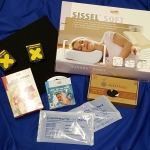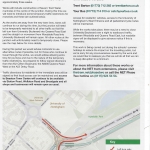June Focus
Are you drinking enough water?
Increasing your water intake could help you lose weight and boost your energy levels. It is also essential for maintaining health and youthful looking skin.
We can often confuse hunger as a sign of dehydration, so get drinking first!
June challenge
Calculate the volume of water you need to drink using this simple calculation and try and stick to it.
Calculate your body weight in pounds
Divide it by two
This is the number of fluid ounces you require
To convert to ml times it by 28.5
e.g. If you weigh 10 stone = 140 lbs
140/2 = 70 fl oz
70 X 28.5 = 1.995ml so about 2 litres a day… easy..
Try and drink most of your water before midday so you are not going to the loo all night.
For further help and information talk to one of our team
More
 The lucky winners of our draw for Chiropractic Awareness Week are the following:
The lucky winners of our draw for Chiropractic Awareness Week are the following:
Louise O’Sullivan -ice pack
Emily Connelly – ice pack
Karen Cox – Hot / cold gel pack
Val Sedgley – Wheat wrap
Sandra Hildrew – Cherry hot pack
Rachel French – Sports Tape
XXXXXXX-Sports tape
Claire Turner – Wedge cushion
Becky Morley – Orthopaedic Pillow
PLEASE COLLECT YOUR PRIZE FROM THE CLINIC BEFORE 30th APRIL 2016.
Thank you so much to everyone who liked and shared our posts and making it a successful week, we wish you could all have had prizes.
If you are new to the clinic please take advantage of our FREE advice and posture check sessions- call reception for details.
If you are a member of a group who you think would be interested in one of our team coming and sharing some heath tips with them, then give us a call.
Look out for top tips and podcasts in future posts and check out our website for clinic news and information videos
www.beestonchiropractic.co.uk.
More
As part of Chiropractic Awareness Week we are urging workers to do more to protect their backs, both in the office and at home. Follow us on Facebook this week to learn more.
Get a chance to win one of these prizes for liking and sharing our page.
Every Face book follower who likes and shares our page will be put into the draw for a prize. You can like and share us every day to get lots of chances to win.
Like and share must be before 12 noon on Saturday 16th April 2016 to qualify.
The results of the draw will be announced on Face book and this web site on Monday 18th April 2016.
Prizes must be collected from the clinic by 12 noon on Saturday 30th April 2016
Good Luck and thank you for joining us.
The research was carried out on behalf of the British Chiropractic Association between 27/01/2016 and 02/02/2016.
More
Spring has sprung!!
Winter hibernation is coming to an end and many will be starting to think about Spring gardening jobs. It’s great to get outdoors and blow the cobwebs away but take care of your back with our great advice.
Clothes
- Don’t wear clothes that are tight or could constrict your movement.
Warm Up
- Gardening is like any other exercise; you need to warm up first. Don’t go straight into the heavy work; start off with lighter jobs as this will lessen the chance of muscle strain.
Take a break
- Vary your activity by spending no more than 20-30 minutes on any one thing and make sure you take regular breaks.
Clever spring pruning
- Get as close as possible to the things you are pruning and avoid overstretching to reach the area you are dealing with.
- Invest in some long handled secateurs to reach plants and bushes that are beyond normal reach.
Plan ahead
- If you are planning a trip to the local garden centre store to buy heavy items such as compost, buy smaller bags rather than one big bag as they are easier and safer to carry. Better still, have it delivered direct to your home.
- Don’t lift with your arms straight out, keep the elbows bent and to your side to minimise the stress on your back.
- If having items delivered, have them unloaded as close to where you need them as possible; this will save the effort of moving them again.
- A specialist garden trolley might be worth investing in to move these sorts of materials around, especially if you have lots of patio pots to move around as well.
More
Are you a spoon or a bridge?
The shape of a woman’s side profile could be used as an indicator of neck and back problems. According to research from the British Chiropractic Association (BCA), the average age where women start to suffer from back or neck pain is 34.
Women whose heads lean forward are most likely to be currently suffering from back or neck pain (58%), followed by those with an arched back (56%).
Women whose heads lean forward are also the most likely to suffer from back or neck pain ‘every day’ (29%). Those with a flat back were the least likely to have experienced pain, with 21 per cent having remained pain-free.*
Although many women would recognise what category they fall into when it comes to the more traditional body shapes, knowing about their side-shapes is important too.
BCA Chiropractor, Tim Hutchful, comments: “Rather than worrying about being an apple or an hourglass, we want people to think about what they look like from the side. Paying closer attention to your body’s side profile can really help to identify back or neck pain triggers.”
What side-shape are you?
• Spoon – flat back, rounded shoulders
• Leaning tower – head leans forward
• Bridge – arched back
• Flat-pack – flat back
With just over 25 per cent of women saying that a bout of back or neck pain can last for one to three days at a time, it is important to pinpoint what can be done to prevent it. Fortunately, making changes to your posture doesn’t call for extreme dieting or exercise programmes.
Tim Hutchful explains: “The perfect posture should give you a neutral side-on appearance, with your ears, shoulders, hips, knees and ankles in line.
“People who want to improve their back and neck pain symptoms through a better posture should try imagining they have a plumb line hanging straight from their ears to ankles – with everything in the middle sitting on the same line.
“One way to do this is to try standing in a relaxed way and then gently contracting the abdominal muscles. When sitting, the gravity line should pass thorough ear, shoulder and hip.”
The BCA has also developed a programme of simple stretches and exercises, designed to improve posture and help prevent back pain by promoting balance, strength and flexibility in the spine. Click here to view.
Research carried out on behalf of the BCA in January 2015.
*Out of all women with an arched back, a flat back, rounded shoulders, or head leaning forwards
More
Introducing Family Loyalty Cards – collect yours from reception today.
As from 1st January2016
Terms and conditions
We are introducing a new Family Loyalty Card from 1st January 2016
This is an opportunity to collect stamps towards discount off your treatment with your chiropractor.
You can earn your stamps in the following ways:
- If you or a member of your family pays the full chiropractic treatment fee or full chiropractic treatment child’s fee you can collect a stamp for each treatment you or your family member receives. (All Insurance claims, F&F and infant rates are excluded.)
- By referring a family member, friend or colleague to the clinic. This can be collected after they become a new patient. (This replaces the referral credit previously offered)
- By completing the Care Response online questionnaires offered to all new patients with email addresses, when you come in with new problems or if we haven’t seen you for a while.
When your card is full you can enjoy the discount offered off your next chiropractic treatment.
Your full card can only be redeemed against a chiropractic treatment and this can only be with the main chiropractor that you are registered with.
There is no time date on using your loyalty card but it must be complete to qualify for the treatment discount.
Your points cannot be exchanged for cash
More
SUFFERING IN SILENCE…
Failure to self-care sees those in the Midlands living with back pain for up to 10 years
More than three out of four (76%) people surveyed in the Midlands have been suffering with neck or back pain for up to 10 years according to new research from the British Chiropractic Association, as many admit they don’t take proactive measures to look after their backs.
Now Alex Newton from Beeston Chiropractic Clinic is encouraging people to practice greater self-care and incorporate simple steps into their daily routine to help prevent back and neck pain before it causes longer term problems.
The new findings revealed that 43% of people of admit they have never done anything to actively protect their backs, and over a quarter (28%) of people in the Midlands have confessed that they have been unable to work due to their back or neck pain.
Over half (56%) think that sitting in the same position for long periods of time has the most negative impact on their back. However, despite recognising the source of pain, one in 10 (10%) of those who spend the day mainly in one position don’t take regular breaks.
In terms of what measures people would consider taking to protect their backs, 6% would see a trained health professional, but many more said they would try home remedies such as heat treatment (52%), rest (41%) or over the counter medication (36%) to solve their back or neck problems.
BCA chiropractor Alex Newton from Beeston Chiropractic Clinic, says: “As modern lifestyles put increasing amounts of strain on our backs and necks it’s becoming even more important for people to take proactive measures to protect their backs. Yet, we are seeing more and more people who have been struggling with back pain for longer periods of time.
“Prevention is always better than cure and it’s encouraging to see that some people told us they are taking steps to maintain a healthy posture, including limiting the amount of time they spend on laptops. However, there are a number of other simple processes that people can incorporate into their daily routine to reduce the effect that back and neck pain can have on their everyday lives. For example, people are often surprised at the positive impact that simply ensuring you take regular breaks when sitting for long periods of time, and keeping hydrated can have on your back.”
So, how can we battle back pain before it becomes a problem?
Beeston Chiropractic Clinic offers the following top tips to help people keep back pain at bay:
- Stop the slouch: Relax when sitting into your seat, making sure you have your bottom against the seat back with your shoulder blades touching the back rest of the chair. For drivers; the back of the seat should be set slightly backwards, so that it feels natural and your elbows should be at a comfortable and relaxed angle for driving.
- Get up, stand up: Don’t sit for more than 20-30 minutes at a time – stand up to stretch, change position and walk around a little. If you struggle to get away then take time to gently massage the back of your head and neck as you relax your stomach region with slow easy breathing. This will help to improve posture and reduce back pain by promoting balance, strength and flexibility in the spine.
- Walk on: Adding just a few minutes walking to your daily routine could be of benefit. For example, walk to the shops instead of driving; try walking a little faster to boost the exercise benefit; take the stairs instead the lift.
- Drink up!: Try drinking water instead of tea or coffee; it will be healthier and keep your body hydrated.
For more information on how to maintain a healthy posture and help keep neck and back pain at bay, the BCA has developed ‘Straighten Up’ – a simple, three minute exercise programme for all ages, designed to help strengthen the spine and improve posture and help joints. To watch a video of the exercises you can do, please visit: www.chiropractic-uk.co.uk.
Beeston Chirorpactic Clinic
191 Queens Road
Beeston
Nottingham NG9 2BZ 0115 9225085
Notes to editors
- The research was carried out between: 07/01/2015 and 20/01/2015. Sample: 2,127 UK adults aged 18 – 65 by Opinion Matters on behalf of the British Chiropractic Association. Midlands sample size: 379.
More
New research from
INRIX has found that UK drivers are spending more and more time at a standstill on the roads.
In 2014, people in the UK wasted an average of 30 hours a year sitting in traffic, elevating it to the 5th worse position in Europe. Within the UK, London was by far the worse place for traffic hold ups, with people wasting up to 96 hours a year in road congestion.
With the prospect of more and more time spent at a standstill in the same position in the car, it’s more and more important to make sure you take measures to protect your back when out driving.
Make adjustments
– Take the time before you set out to get your seat adjusted into the right position for you: The back of the seat should be set slightly backwards, so that it feels natural and your elbows should be at a comfortable and relaxed angle for driving.
Steering wheel
– Once you have adjusted your seat correctly, your hands should fall naturally on the steering wheel, with just a slight bend in the arms.
If the wheel is too high and far away, tension will build up in your shoulders and upper back. If it is too low and close to you, the wheel may be touching your legs, which will reduce your ability to turn it freely, putting strain on the wrists and the muscles of the upper back.
Mirrors
Your reactions must be quick, so you should not need to move your head a lot. The mirror positions should allow you to see all around the car with the movement of your eyes with minimal head movement.
– Set your mirror positions to suit you before you drive off.
Seatbelts
– Your seatbelt should always lie across the top of your shoulder and never rub against your neck or fall onto the top of your arm.
– Depending on your height, you may need to adjust the position at which the seat belt emerges from the body of the car. (If the adjustments available are insufficient, it is possible to purchase clips that help you adjust your seat belt height without impairing safety.)
Footwear
– Once you have adjusted your seat correctly, your feet should fall naturally onto the pedals. You should be able to press the pedals to the floor by mainly moving your ankle and only using your leg a little.
– Avoid wearing wear high heels, or very thick-soled shoes, as you will have to over-extend the ankle in order to put pressure on the pedals. As well as making it much harder to deal with an emergency stop, this position will raise your thigh from the seat (reducing support to your leg) and create tension (and possibly cramp) in the calf. This, in turn, will impair the blood flow on a long journey.
Relax
– A relaxed driving position reduces stress on the spine, allowing your seat to take your weight.
– Take regular breaks – this is important if you are likely to get caught up in delays later.
– Clench your cheeks – If you are stuck in traffic, exercise in your seat. Try buttock clenches, side bends, seat braces (pushing your hands into the steering wheel and your back into the seat – tensing and relaxing) as well as shoulder shrugs and circles.
– It’s all in the timing – Allow plenty of time for journeys to avoid stress.
More
Road works at the Queens Road East /
University Boulevard Junction
From Friday 24th July for three weeks!
Plan ahead for an easier journey
For further information please visit: thetram.net/phasetwo


More
The phone system is reinstated and the number 0115 9225085 can now be used again thank you for your patience
More



